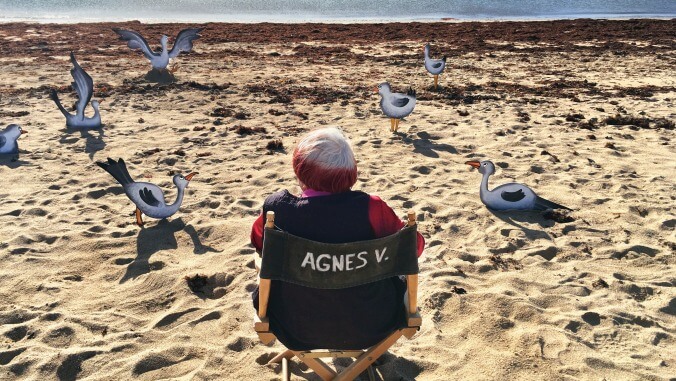Agnès Varda was never in any danger of becoming irrelevant. Where some artists creatively calcify with age, the visionary French filmmaker continued to nurture her curiosity about the world up until her death in March at the age of 90. That same curiosity drives what will stand as Varda’s last work as a writer-director, Varda By Agnès. Released as a two-part TV series in France and then combined into one film for international audiences, Varda By Agnès is knitted together from a series of lectures in which Varda delves into her philosophy of filmmaking and walks audiences through her body of work. As a result, it isn’t as cohesive or inspired as her penultimate film, the Oscar-nominated Faces Places. But as a parting gift from one of the most singular creative minds of the 20th century, it’s as life-affirming as they come.
Varda By Agnès opens with the image of a humble director’s chair sitting on the stage of an ornately filigreed French opera house. Varda walks out on stage, settles into the chair, and begins—as she puts it later in the film—“playing the role” of the wise master, explaining that her creative life has been driven by three words: “imagination,” “creation,” and “sharing.” (They don’t all rhyme in French, either.) The digital camerawork is a bit flat, the lighting a bit harsh, and the whole thing resembles nothing more than one of those online MasterClass lectures that are fascinating in content but unremarkable in style. Then she starts talking about the death imagery in her 1962 film Cléo From 5 To 7, and the aspect ratio abruptly changes from 16:9 to 4:3 as we cut to vintage interview footage about the film. Varda’s cine-collaging has begun.
The flow between topics in Varda By Agnès is stream of consciousness, anecdotes triggered by something as simple as two words with similar sounds. But though the film is stubbornly non-chronological, an arc does emerge, drawing a line from Varda’s early career to her feminist activism to her years living in Los Angeles with her husband Jacques Demy (who died in 1990) to her eventual abandonment in the late ’90s of narrative filmmaking in favor of documentary and installation art. The New Wave veteran credits that last bit to the intimacy and spontaneity of digital video, which she identifies as a “narcissistic” tool for self-documentation. It’s hard to imagine Varda ever being narcissistic, however, particularly while watching her interview a parade of collaborators, matching their effusive praise and clear affection for her beat for beat.
She speaks at length in Varda By Agnès about the importance of editing in shaping a narrative, a lesson that’s reflected in the scrapbook-esque multimedia quality of the film. Although Varda’s arc is anchored by the contemporary lecture footage mentioned above, clips from her films are interwoven throughout, as are—to a lesser extent—whimsically staged scenes that Varda describes as “reality with a twist.” The most charming of these involve Faces Places’ JR, who helps Varda arrange volunteers into a living eye chart for a segment about her fading sight, and Vagabond star Sandrine Bonnaire, whose interview with her director takes place on a dolly track similar to the one used for that film. Compared to Varda’s use of similar sequences in The Beaches Of Agnès and Faces Places, however, these feel somewhat perfunctory, not least because they cover much of the same territory.
Varda By Agnès is most valuable as a freestanding lesson in filmmaking. As with much of Varda’s autobiographical work, at least some foreknowledge of her filmography is helpful in order to follow the whims of the storytelling. But with careful attention and a notepad, you could use it as an introductory course on her life and career. More importantly, the documentary also contains detailed, invaluable insights into Varda’s process, covering topics like color symbolism and supporting subtextual themes with visual technique. But what film students really need to hear are her thoughts on humane creation, instructing aspiring filmmakers to approach their subjects with humility, empathy, and love. The world lost a little bit of light when Agnès Varda left it, and it’s evidence of her profound generosity of spirit that her last act as an artist was to leave instructions on how to nurture the light within us all.










![Rob Reiner's son booked for murder amid homicide investigation [Updated]](https://img.pastemagazine.com/wp-content/avuploads/2025/12/15131025/MixCollage-15-Dec-2025-01-10-PM-9121.jpg)

























![HBO teases new Euphoria, Larry David, and much more in 2026 sizzle reel [Updated]](https://img.pastemagazine.com/wp-content/avuploads/2025/12/12100344/MixCollage-12-Dec-2025-09-56-AM-9137.jpg)




